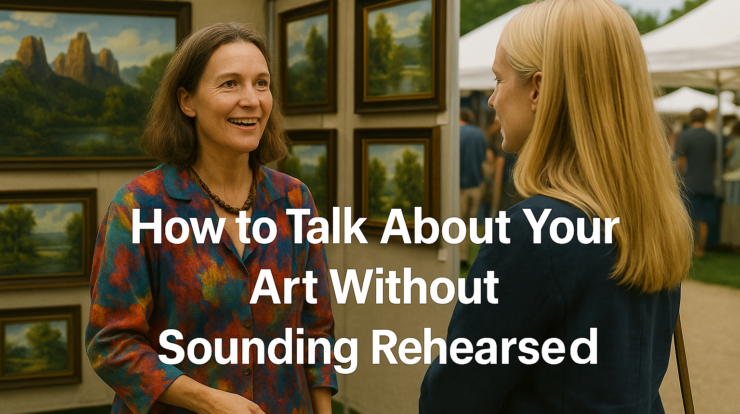
If you’ve ever caught yourself repeating the same line about your work for the tenth time at a show—and hearing it fall flat—you’re not alone. One of the most common struggles artists face at events is figuring out how to talk about their work in a way that feels natural and engaging.
The goal isn’t to sound like a polished salesperson. It’s to create a real connection—to share enough of your story that someone feels drawn in, curious, maybe even inspired to make your work part of their life.
So how do you do that without sounding stiff, scripted, or like you’re reading off a brochure?
Start With Stories
People don’t remember facts; they remember stories. Instead of launching into technical details, try telling a short story about what inspired the piece. Was there a place, a memory, or even a conversation that sparked the idea? Did the process surprise you along the way?
A story gives someone a way into your work—it helps them feel what you felt while making it.
You don’t need to tell the whole life story behind every piece. A few lines is often enough:
“This piece came out of a hike I took in the Superstition Mountains right after a monsoon. The colors were so saturated I felt like I was seeing everything in HDR.”
Now you’ve opened the door. If someone wants to know more, they’ll ask. And they’ll be more likely to stick around long enough to ask.
Talk About Your “Why”
Collectors often aren’t just buying a piece of art—they’re buying a connection to something bigger. That’s why your artist’s statement and individual artwork descriptions matter. I’ve talked before about the importance of writing clear statements: not just for others, but for yourself.
Writing down your philosophy and intentions—whether for a bio, an exhibit, or a show catalog—can help you put language to what you’re doing. And once you’ve written it, you’ll find it easier to say it when someone asks, “So what’s your work about?”
You don’t have to recite your statement verbatim. But drawing from it will help you speak with confidence and clarity, especially when nerves creep in.
Prepare a Few Rotating Intros
If you’re doing a multi-day event or a full show season, you’ll want to avoid the “auto-repeat” syndrome. One way to do that is to have a few different openers ready to go. Here are a few types you might use:
-
The story intro: “This series came out of a dream I had during the pandemic—sounds strange, but I woke up and knew exactly what I wanted to paint.”
-
The process intro: “All of these are done in cold wax and oil—it’s a slow layering process that lets me experiment with texture.”
-
The personal mission intro: “What I’m always trying to do is create a sense of calm—something that gives the viewer space to breathe.”
Mixing up your approach will keep you from sounding robotic and help you find the right tone for each conversation.
Practice, Then Let It Be Natural
It’s okay to practice ahead of time. In fact, I’d recommend it—just not to the point where your delivery starts sounding memorized. Think of it like a jazz musician learning the chord structure so they can improvise freely once the tune starts.
Use conversations at smaller events or studio visits to try things out. Notice what resonates. Notice when someone’s eyes light up or when they lean in. You’ll start to build your own rhythm and vocabulary.
In Summary
Talking about your art doesn’t need to feel forced. You’re not giving a TED Talk—you’re inviting someone into your creative world.
Write thoughtful statements for your work. Reflect on your “why.” Prepare a few different ways to start the conversation. Then relax and let the rest unfold naturally.
The right words don’t just help sell the work—they help build the relationships that lead to long-term collectors and lasting impact.